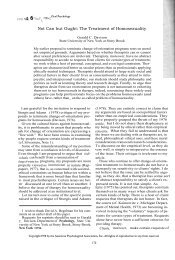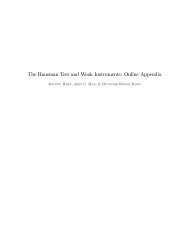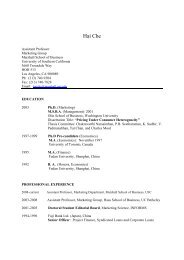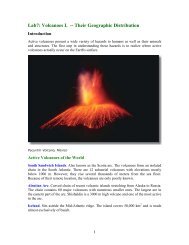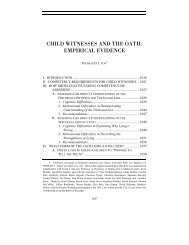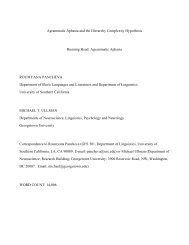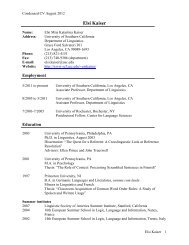Ubiquitous Access to Distributed Data in Large-Scale Sensor ...
Ubiquitous Access to Distributed Data in Large-Scale Sensor ...
Ubiquitous Access to Distributed Data in Large-Scale Sensor ...
Create successful ePaper yourself
Turn your PDF publications into a flip-book with our unique Google optimized e-Paper software.
<strong>Ubiqui<strong>to</strong>us</strong> <strong>Access</strong> <strong>to</strong> <strong>Distributed</strong> <strong>Data</strong> <strong>in</strong> <strong>Large</strong>-<strong>Scale</strong> <strong>Sensor</strong><br />
Networks through Decentralized Erasure Codes<br />
Alexandros G. Dimakis, V<strong>in</strong>od Prabhakaran, and Kannan Ramchandran<br />
Department of Electrical Eng<strong>in</strong>eer<strong>in</strong>g and Computer Science,<br />
University of California, Berkeley, CA 94704.<br />
Email: {adim, v<strong>in</strong>odmp, kannanr}@eecs.berkeley.edu<br />
Abstract— Consider a large-scale wireless sensor network of n nodes,<br />
where a fraction k out of n generate data packets of global <strong>in</strong>terest. Assum<strong>in</strong>g<br />
that the <strong>in</strong>dividual nodes have limited s<strong>to</strong>rage and computational<br />
capabilities, we address the problem of how <strong>to</strong> enable ubiqui<strong>to</strong>us access<br />
<strong>to</strong> the distributed data packets.<br />
Specifically, we assume that each node can s<strong>to</strong>re at most one data<br />
packet, and study the problem of diffus<strong>in</strong>g the data so that by query<strong>in</strong>g<br />
any k nodes, it is possible <strong>to</strong> retrieve all the k data packets of <strong>in</strong>terest<br />
(with high probability).<br />
We <strong>in</strong>troduce a class of erasure codes and show how <strong>to</strong> solve<br />
this problem efficiently <strong>in</strong> a completely distributed and robust way.<br />
Specifically we show that we can efficiently diffuse the data by “prerout<strong>in</strong>g”<br />
only O(ln n) packets per data node <strong>to</strong> randomly selected s<strong>to</strong>rage<br />
nodes. By us<strong>in</strong>g the proposed scheme, the distributed data becomes<br />
available “at the f<strong>in</strong>gertips” of a potential data collec<strong>to</strong>r located anywhere<br />
<strong>in</strong> the network<br />
I. INTRODUCTION<br />
The popular approach <strong>to</strong> retriev<strong>in</strong>g data <strong>in</strong> wireless sensor networks<br />
is for the query unit <strong>to</strong> ask for the data from the sensor nodes<br />
of <strong>in</strong>terest. The desired data is then routed from the source nodes<br />
<strong>to</strong> the data collec<strong>to</strong>r. This may be categorized as a “pull-based”<br />
strategy. In certa<strong>in</strong> scenarios of <strong>in</strong>terest, a pull-based approach at<br />
query time may have limitations. Primarily, there can potentially be a<br />
large latency <strong>in</strong> gett<strong>in</strong>g the desired data out of a multitude of source<br />
nodes scattered randomly across the network due <strong>to</strong> the multi-hop<br />
rout<strong>in</strong>g phase follow<strong>in</strong>g the query. There is a tradeoff between the<br />
work performed at the time the data is generated relative <strong>to</strong> the work<br />
performed at query time. In general, process<strong>in</strong>g done at query time<br />
<strong>in</strong>troduces latency and unreliability that may not be acceptable for<br />
certa<strong>in</strong> applications.<br />
This work is accord<strong>in</strong>gly motivated at try<strong>in</strong>g <strong>to</strong> reduce latency and<br />
unreliability between query time and the time that the desired data<br />
is made available <strong>to</strong> the data collec<strong>to</strong>r. In the spirit of “smart dust”<br />
sensor networks [6], we consider a very large scale network with <strong>in</strong>dividual<br />
nodes severely constra<strong>in</strong>ed by communication, computation,<br />
and memory. When one envisions large numbers of cheap, unreliable<br />
sensors it is very reasonable <strong>to</strong> <strong>in</strong>troduce redundancy <strong>to</strong> ensure that<br />
the whole network is act<strong>in</strong>g as a robust distributed s<strong>to</strong>rage database.<br />
Of particular importance is the assumption that memory cannot scale<br />
with the size of the network.<br />
We study the <strong>in</strong>terest<strong>in</strong>g case where a data collection query can<br />
be posed anywhere <strong>in</strong> the network (e.g. a mobile query unit) and<br />
require quick and reliable access <strong>to</strong> the data of <strong>in</strong>terest, which<br />
is scattered randomly throughout the network. Clearly, this would<br />
require some sort of a “pre-rout<strong>in</strong>g” phase where<strong>in</strong> the network needs<br />
<strong>to</strong> be prepared so as <strong>to</strong> allow for this low latency query answer<strong>in</strong>g<br />
capability. The key issue, of course, is whether it is possible <strong>to</strong> achieve<br />
This research was supported by NSF under grants CCR-0219722 and CCR-<br />
0330514. This work has been presented <strong>in</strong> part at Asilomar 2004 [4].<br />
this robust distributed s<strong>to</strong>rage under the communication and s<strong>to</strong>rage<br />
constra<strong>in</strong>ts imposed by the nature of wireless sensors.<br />
Our ma<strong>in</strong> result is a novel scheme for data dissem<strong>in</strong>ation that<br />
can guarantee ubiqui<strong>to</strong>us access <strong>to</strong> distributed data by hav<strong>in</strong>g only<br />
O(ln n) pre-routed packets per data node. In the proposed solution,<br />
each node operates au<strong>to</strong>nomously without any central po<strong>in</strong>ts of<br />
control. Our solution is based on a new class of erasure codes called<br />
decentralized erasure codes. These codes have the unique property<br />
that they can be created <strong>in</strong> a distributed way without gather<strong>in</strong>g all<br />
the <strong>in</strong>put data at one centralized location.<br />
The rema<strong>in</strong>der of the paper is organized as follows: In Section 2 we<br />
give the exact problem formulation, state our assumptions and discuss<br />
related work. In Section 3 we <strong>in</strong>troduce decentralized erasure codes<br />
and present the theorems describ<strong>in</strong>g their performance. In Section<br />
4 we give some examples of us<strong>in</strong>g decentralized erasure codes <strong>in</strong><br />
specific network sett<strong>in</strong>gs and present some experimental performance<br />
evaluation. We also present some <strong>in</strong>terest<strong>in</strong>g extensions of the basic<br />
model. F<strong>in</strong>ally, Section 5 conta<strong>in</strong>s the proofs of our theorems.<br />
II. PROBLEM SETTING<br />
We assume that there are k data-generat<strong>in</strong>g nodes that are measur<strong>in</strong>g<br />
a physical quantity of <strong>in</strong>terest (e.g. temperature). Without loss<br />
of generality we will assume that each data node generates one data<br />
packet of large size conta<strong>in</strong><strong>in</strong>g the measurements over some time<br />
<strong>in</strong>terval.<br />
In our <strong>in</strong>itial problem sett<strong>in</strong>g we will assume the data packets<br />
are <strong>in</strong>dependent. In most <strong>in</strong>terest<strong>in</strong>g sens<strong>in</strong>g scenarios the data will<br />
be highly correlated and we show how our scheme can perform<br />
distributed source cod<strong>in</strong>g <strong>to</strong> compress correlated data. Essentially,<br />
after distributed compression, the large correlated data packets can<br />
be replaced by smaller packets that are <strong>in</strong>dependent and have the<br />
theoretically smallest possible size, equal <strong>to</strong> the jo<strong>in</strong>t entropy of the<br />
physical sources.<br />
Further, assume we have n > k s<strong>to</strong>rage nodes that will be used as<br />
s<strong>to</strong>rage and relay devices. <strong>Sensor</strong> nodes have limited memory and we<br />
model that by assum<strong>in</strong>g that each node (of any k<strong>in</strong>d) can s<strong>to</strong>re, (wlog)<br />
only one data packet (or a comb<strong>in</strong>ation hav<strong>in</strong>g the same number of<br />
bits as a data packet). This is a key requirement <strong>to</strong> the scalability<br />
of the network. A data packet conta<strong>in</strong>s measurements over a time<br />
<strong>in</strong>terval and can have significant size.<br />
The ratio k/n < 1 is assumed fixed as k and n scale. For example<br />
we can assume that some fixed ratio (for example 10%) of nodes <strong>in</strong><br />
a sensor network are measur<strong>in</strong>g while the rest are used for s<strong>to</strong>rage.<br />
To avoid confusion one can th<strong>in</strong>k that the <strong>to</strong>tal number of sensors<br />
is n + k or that some k out of the n sensors have an extra sens<strong>in</strong>g<br />
device which is operat<strong>in</strong>g completely <strong>in</strong>dependently from the s<strong>to</strong>rage<br />
device. However, as will become apparent <strong>in</strong> subsequent sections, our<br />
framework is much more general and the k data nodes and n s<strong>to</strong>rage
nodes can be any arbitrary (possibly overlapp<strong>in</strong>g) subsets of nodes<br />
<strong>in</strong> a larger network of N nodes.<br />
Throughout this paper we will be <strong>in</strong>terested <strong>in</strong> answer<strong>in</strong>g data<br />
collection queries that <strong>in</strong>volve gather<strong>in</strong>g all k data packets <strong>to</strong> a<br />
collec<strong>to</strong>r. F<strong>in</strong>d<strong>in</strong>g efficient algorithms for answer<strong>in</strong>g other queries<br />
like aggregate and range queries under the proposed encoded s<strong>to</strong>rage<br />
scheme rema<strong>in</strong>s as future work.<br />
We want <strong>to</strong> s<strong>to</strong>re the <strong>in</strong>formation conta<strong>in</strong>ed <strong>in</strong> the k data nodes<br />
<strong>in</strong> a redundant way <strong>in</strong> all the n s<strong>to</strong>rage nodes. As there are k data<br />
packets of <strong>in</strong>terest, and each node can s<strong>to</strong>re no more than 1 data<br />
packets worth of bits, it is clear that one has <strong>to</strong> query at least k<br />
nodes <strong>to</strong> get the desired data.<br />
The problem is <strong>to</strong> s<strong>to</strong>re the data <strong>in</strong> such a way that users may<br />
query any k nodes and use the results <strong>to</strong> reconstruct the orig<strong>in</strong>al k<br />
packets (with high probability). For <strong>in</strong>stance, a data collec<strong>to</strong>r can get<br />
this data out of some k neighbor<strong>in</strong>g s<strong>to</strong>rage nodes <strong>in</strong> its immediate<br />
vic<strong>in</strong>ity <strong>to</strong> m<strong>in</strong>imize the latency.<br />
F<strong>in</strong>ally we assume that the data collec<strong>to</strong>r has enough memory <strong>to</strong><br />
s<strong>to</strong>re k packets and enough process<strong>in</strong>g power <strong>to</strong> run the maximum<br />
likelihood decod<strong>in</strong>g algorithm, which as we will show corresponds<br />
<strong>to</strong> solv<strong>in</strong>g a system of k l<strong>in</strong>ear equations <strong>in</strong> a f<strong>in</strong>ite field.<br />
Our proposed solution requires no rout<strong>in</strong>g tables, centralized<br />
process<strong>in</strong>g or global knowledge of any sort. We only assume a packet<br />
rout<strong>in</strong>g layer that can route packets from po<strong>in</strong>t <strong>to</strong> po<strong>in</strong>t (based for<br />
example on geographic <strong>in</strong>formation). This can be easily achieved with<br />
only local geographic knowledge with greedy geographic or GPSR<br />
[16] rout<strong>in</strong>g. We further assume that there are packet acknowledgements<br />
and therefore, no packets are lost. This last assumption however<br />
can be very easily relaxed due <strong>to</strong> the completely randomized nature<br />
of the solution.<br />
Our solution uses decentralized erasure codes, which we prove<br />
have m<strong>in</strong>imal data node degree, which corresponds <strong>to</strong> a m<strong>in</strong>imal<br />
number of pre-routed messages. Note however, that we do not claim<br />
optimality of the distributed s<strong>to</strong>rage system as a whole. This is<br />
because we rely on a packet rout<strong>in</strong>g layer <strong>in</strong>stead of jo<strong>in</strong>tly optimiz<strong>in</strong>g<br />
across all network layers.<br />
A. Comparison with Centralized Scheme<br />
The problem of reconstruct<strong>in</strong>g the k measurements from any k out<br />
of n s<strong>to</strong>rage nodes can be seen as an erasure channel cod<strong>in</strong>g problem.<br />
If we assume the existence of a centralized super-node that can gather<br />
all the data, we could use any (n, k) capacity achiev<strong>in</strong>g erasure code<br />
and treat the data node packets as <strong>in</strong>put symbols and the s<strong>to</strong>rage nodes<br />
as encod<strong>in</strong>g symbols. More specifically, the centralized node would<br />
gather the k data packets, use an erasure code <strong>to</strong> generate n encoded<br />
packets (with the same size plus a small overhead for identification).<br />
Then, it would assign and send one encoded packet <strong>to</strong> each s<strong>to</strong>r<strong>in</strong>g<br />
node. If we use a good erasure code we will be guaranteed <strong>to</strong><br />
reconstruct the orig<strong>in</strong>al packets by ask<strong>in</strong>g any k encoded s<strong>to</strong>rage<br />
nodes.<br />
The most common erasure codes are Reed-Solomon which are<br />
very widely employed <strong>in</strong> many applications like computer network<br />
distributed s<strong>to</strong>rage systems [18], and redundant disk arrays [3].<br />
Also, LDPC codes and more recently founta<strong>in</strong> codes [19] were<br />
proposed as alternatives with randomized construction and faster<br />
encod<strong>in</strong>g and decod<strong>in</strong>g times. See [22] for a practical <strong>in</strong>vestigation<br />
on us<strong>in</strong>g these codes for distributed s<strong>to</strong>rage.<br />
The key feature of our problem that makes these codes unsuitable<br />
is the fact that the data is distributed. We could convert the problem<br />
<strong>to</strong> a centralized one by gather<strong>in</strong>g all the data <strong>in</strong> one super-node<br />
and us<strong>in</strong>g any erasure code. This would have some advantages and<br />
some disadvantages compared with the decentralized scheme. On the<br />
positive side, a centralized solution would allow the use of Reed<br />
Solomon codes which have determ<strong>in</strong>istic (as opposed <strong>to</strong> probabilistic)<br />
guarantees for decod<strong>in</strong>g. Also, the use of LT or LDPC codes would<br />
allow for faster decod<strong>in</strong>g times relative <strong>to</strong> the proposed codes.<br />
However, on the negative side, this does not constitute a scalable<br />
solution from a computational power, s<strong>to</strong>rage and communication<br />
po<strong>in</strong>t of view. Specifically gather<strong>in</strong>g all the data <strong>in</strong> one place would<br />
create a network hotspot, and <strong>in</strong>troduce security and unreliability<br />
problems if the super-node fails. In summary, the centralized solution<br />
might be preferable for small networks but would def<strong>in</strong>itely have<br />
problems as the number of nodes <strong>in</strong>creases.<br />
B. Related work<br />
The standard approach <strong>in</strong> query process<strong>in</strong>g is <strong>to</strong> flood queries<br />
<strong>to</strong> all nodes, and construct a spann<strong>in</strong>g tree by hav<strong>in</strong>g each node<br />
ma<strong>in</strong>ta<strong>in</strong> a rout<strong>in</strong>g table of their parents. This is the approach<br />
currently used <strong>in</strong> both T<strong>in</strong>yDB and Cougar [20]. Flood<strong>in</strong>g can be<br />
pruned by construct<strong>in</strong>g an analog <strong>to</strong> <strong>in</strong>dexes <strong>in</strong> the network. An<br />
efficient <strong>in</strong>dex<strong>in</strong>g scheme is the Geographic Hash Table (GHT),<br />
which maps IDs and nodes <strong>to</strong> a metric space [26]. These approaches<br />
yield different tradeoffs between reliability over network changes,<br />
latency and communication cost. Decentralized erasure codes can<br />
be used <strong>to</strong> add s<strong>to</strong>rage redundancy <strong>in</strong> any exist<strong>in</strong>g query process<strong>in</strong>g<br />
scheme when reliability is required.<br />
There has been significant work on multiresolution distributed<br />
s<strong>to</strong>rage for sensor networks. Ganesan et al. [9], [10] propose the<br />
DIMENSIONS system which uses wavelets <strong>to</strong> efficiently summarize<br />
sensor data <strong>in</strong> a natural hierarchical structure. Gao et al. [12] exploit<br />
the pr<strong>in</strong>ciple of fractionally cascaded <strong>in</strong>formation <strong>to</strong> provide efficient<br />
algorithms and theoretical bounds for answer<strong>in</strong>g range queries.<br />
Our work can be comb<strong>in</strong>ed with multiresolution s<strong>to</strong>rage mechanisms<br />
as an <strong>in</strong>terest<strong>in</strong>g way of s<strong>to</strong>r<strong>in</strong>g <strong>in</strong>formation <strong>in</strong> sensor networks.<br />
We briefly address this issue on Section 4 but more explicit<br />
<strong>in</strong>vestigations on jo<strong>in</strong>tly optimiz<strong>in</strong>g summarization and decentralized<br />
erasure code construction rema<strong>in</strong> as part of our ongo<strong>in</strong>g work.<br />
The family of adaptive pro<strong>to</strong>cols called <strong>Sensor</strong> Pro<strong>to</strong>cols for Information<br />
via Negotiation (SPIN) [17] dissem<strong>in</strong>ates all the <strong>in</strong>formation<br />
<strong>to</strong> every node <strong>in</strong> the network. This enables a user <strong>to</strong> query any node<br />
and get the required <strong>in</strong>formation immediately by only communicat<strong>in</strong>g<br />
with one node. This is similar <strong>in</strong> spirit of the current work but relies<br />
on the assumption that each sensor node has enough memory <strong>to</strong> s<strong>to</strong>re<br />
all the data <strong>in</strong> the network, clearly not a scalable solution.<br />
The proposed codes are l<strong>in</strong>ear codes with a structured randomized<br />
construction and are therefore related with LDPC [8] and LT codes<br />
[19]. In addition, there are some <strong>in</strong>terest<strong>in</strong>g connections with the<br />
rateless property of digital founta<strong>in</strong> codes. These connections are<br />
made explicit <strong>in</strong> a subsequent section.<br />
C. Connections <strong>to</strong> Network Cod<strong>in</strong>g<br />
Decentralized erasure codes can be seen as l<strong>in</strong>ear Network codes<br />
[13], [14], [15] on the (random) bipartite graph connect<strong>in</strong>g the data<br />
and the s<strong>to</strong>rage nodes (where each edge corresponds <strong>to</strong> one prerouted<br />
packet). Network cod<strong>in</strong>g is an excit<strong>in</strong>g new paradigm for<br />
communication <strong>in</strong> networks. This paper <strong>in</strong>vestigates some connections<br />
between network cod<strong>in</strong>g and codes for distributed s<strong>to</strong>rage. A<br />
related <strong>in</strong>vestigation on applications of network cod<strong>in</strong>g on random<br />
graphs can be found <strong>in</strong> [7].<br />
An equivalent way of th<strong>in</strong>k<strong>in</strong>g of the distributed s<strong>to</strong>rage problem<br />
is that of a random bipartite graph connect<strong>in</strong>g the k data nodes<br />
with the n s<strong>to</strong>rage nodes and then add<strong>in</strong>g a data collec<strong>to</strong>r for
every possible subset of size k of the n s<strong>to</strong>rage nodes. Then the<br />
problem of multicast<strong>in</strong>g the k data packets <strong>to</strong> all the data collec<strong>to</strong>rs is<br />
equivalent <strong>to</strong> mak<strong>in</strong>g sure that every collection of k s<strong>to</strong>rage nodes can<br />
reconstruct the orig<strong>in</strong>al packets. It has been shown that random l<strong>in</strong>ear<br />
network codes [15] are sufficient for multicast<strong>in</strong>g problems as long as<br />
the the underly<strong>in</strong>g network can support the required throughput. The<br />
key difference between classical network cod<strong>in</strong>g and our problem is<br />
that <strong>in</strong> network cod<strong>in</strong>g, one is given a fixed multicast<strong>in</strong>g network and<br />
tries <strong>to</strong> maximize throughput. In our problem, the code is created over<br />
the random, bipartite graph connect<strong>in</strong>g data and s<strong>to</strong>rage nodes. Note<br />
that this graph does not correspond <strong>to</strong> any physical communication<br />
l<strong>in</strong>ks but <strong>to</strong> virtual rout<strong>in</strong>g selections that are made by the algorithm.<br />
Therefore this graph is not given, but can be explicitly designed <strong>to</strong><br />
m<strong>in</strong>imize communication cost. Essentially we are try<strong>in</strong>g <strong>to</strong> make<br />
this random bipartite graph as sparse as possible (because each edge<br />
corresponds <strong>to</strong> communication) while keep<strong>in</strong>g the flow high enough<br />
and also enforc<strong>in</strong>g each data node <strong>to</strong> act <strong>in</strong>dependently, without<br />
coord<strong>in</strong>ation.<br />
The key technical condition we need <strong>to</strong> prove <strong>to</strong> establish that<br />
decentralized erasure codes will be decodable is that the random<br />
bipartite graphs we construct have a perfect match<strong>in</strong>g [1] with high<br />
probability. The existence of a perfect match<strong>in</strong>g guarantees that<br />
the max flow that can go through the network is sufficient. Our<br />
ma<strong>in</strong> theoretical contribution is <strong>in</strong> quantify<strong>in</strong>g how sparse these<br />
random bipartite graphs can be under these constra<strong>in</strong>ts. The proof is<br />
obta<strong>in</strong>ed by us<strong>in</strong>g an extension of a comb<strong>in</strong>a<strong>to</strong>rial count<strong>in</strong>g technique<br />
<strong>in</strong>troduced by P. Erdős and A. Rényi <strong>in</strong> [5], [2] for analyz<strong>in</strong>g<br />
match<strong>in</strong>gs <strong>in</strong> random bipartite graphs. The extension stems from the<br />
dependencies on the data nodes which destroy the symmetry assumed<br />
<strong>in</strong> [5], [2] and thereby complicat<strong>in</strong>g matters (see Section 5 for more<br />
details).<br />
III. DECENTRALIZED ERASURE CODES<br />
Fig. 1. A simple example of a l<strong>in</strong>ear code over GF (2 8 ). Here k = 2,<br />
n = 3, k/n = 2/3, q = 256. The primitive polynomial of the field is<br />
D 8 + D 4 + D 3 + D 2 + 1<br />
Decentralized Erasure Codes are random l<strong>in</strong>ear codes over a f<strong>in</strong>ite<br />
field GF (q) with a specific genera<strong>to</strong>r matrix structure.<br />
A <strong>to</strong>y example of a l<strong>in</strong>ear code over GF (2 8 ) is given <strong>in</strong> figure<br />
(1). In the example there are two data nodes X1 and X2 and three<br />
s<strong>to</strong>rage nodes Y1, Y2, Y3. We assume the data nodes have gathered<br />
a number of measurements. In the example we choose u = 8 bits<br />
<strong>to</strong> represent each number <strong>in</strong> our field which corresponds <strong>to</strong> GF (2 8 ).<br />
The bits of the data measurements are divided <strong>in</strong><strong>to</strong> blocks of u bits<br />
which correspond <strong>to</strong> elements <strong>in</strong> GF (2 8 ) (for example X1(1) =<br />
002, X1(2) = 080, X1(3) = 220). Now the data packet X1 is prerouted<br />
<strong>to</strong> s<strong>to</strong>rage nodes Y1, Y3 and X2 <strong>to</strong> Y2, Y3. Once a s<strong>to</strong>rage node<br />
receives one or more data packets, it selects coefficients fi uniformly<br />
and <strong>in</strong>dependently <strong>in</strong> GF (2 8 ). Each coefficient then multiplies each<br />
blocks <strong>in</strong>dependently, multiple blocks are added (under the arithmetic<br />
of the Galois Field) and the results are cascaded <strong>in</strong><strong>to</strong> a new block<br />
packet Yi that has exactly the same size as all the data packets. So<br />
for example Y3 has s<strong>to</strong>red a packet that corresponds <strong>to</strong> 2X1 + 1X2.<br />
Us<strong>in</strong>g this notation we mean that Y3(i) = 2X1(i) + 1X2(i) for<br />
i = 1, 2, 3. Each s<strong>to</strong>rage node will also s<strong>to</strong>re the coefficients fi that<br />
it selected. This <strong>in</strong>troduces an overhead s<strong>to</strong>rage that can be made<br />
arbitrarily small by cod<strong>in</strong>g over larger blocks, this issue is discussed<br />
<strong>in</strong> more detail <strong>in</strong> a subsequent section.<br />
Notice that <strong>in</strong> Figure 1 any two out of the three encod<strong>in</strong>g packets<br />
can be used <strong>to</strong> reconstruct the orig<strong>in</strong>al data. In general, l<strong>in</strong>ear codes<br />
can be represented us<strong>in</strong>g their genera<strong>to</strong>r matrix <strong>in</strong> the form u = mG<br />
where u is an 1 × n encod<strong>in</strong>g vec<strong>to</strong>r, m is 1 × k <strong>in</strong>put vec<strong>to</strong>r and<br />
G is a k × n matrix. In general the vec<strong>to</strong>rs and the genera<strong>to</strong>r matrix<br />
are general field elements <strong>in</strong> some GF (q). For the example<br />
G = (<br />
1 0 2<br />
0 3 1<br />
) (1)<br />
<strong>to</strong> reta<strong>in</strong> m the receiver must <strong>in</strong>vert a k × k submatrix G ′ of G. The<br />
key property required for successful decod<strong>in</strong>g (that is also true for<br />
the example) is that any selection of G ′ forms a full rank matrix.<br />
A. Code Construction<br />
To construct a decentralized erasure code, each data symbol is<br />
<strong>in</strong>dependently pre-routed <strong>to</strong> d(k) s<strong>to</strong>rage nodes. More specifically,<br />
it picks one out of the n s<strong>to</strong>rage nodes, pre-routes the packet and<br />
repeats d(k) times. Each s<strong>to</strong>rage node multiplies whatever it happens<br />
<strong>to</strong> receive with coefficients selected uniformly and <strong>in</strong>dependently <strong>in</strong><br />
GF (q). A schematic representation of this is given <strong>in</strong> figure 2. This<br />
corresponds <strong>to</strong> generat<strong>in</strong>g each row of the G matrix <strong>in</strong>dependently<br />
by plac<strong>in</strong>g at most d(k) nonzero elements <strong>in</strong> random positions.<br />
Fig. 2. Decentralized erasure codes construction. There are d(k) = c ln(k)<br />
edges start<strong>in</strong>g from each data node and land<strong>in</strong>g <strong>in</strong>dependently and uniformly<br />
on the s<strong>to</strong>rage nodes (If two edges have the same start<strong>in</strong>g and end<strong>in</strong>g po<strong>in</strong>t,<br />
we identify them)<br />
The number of messages pre-routed by each data node is d(k) and<br />
the <strong>to</strong>tal number of packets that will be pre-routed is O(kd(k)). To<br />
m<strong>in</strong>imize the communication cost for a sensor network we want <strong>to</strong><br />
f<strong>in</strong>d the smallest possible d(k) that guarantees that k ×k submatrices
G ′ of the random G we generate will be full rank with high<br />
probability.<br />
The follow<strong>in</strong>g theorems are the ma<strong>in</strong> results of the paper:<br />
Theorem 1: d(k) = c ln(k) is sufficient so that collect<strong>in</strong>g any<br />
random k ×k submatrix G ′ of G is full rank with probability at least<br />
(1 − k<br />
q<br />
)c2(k). ( where c2(k) → 1 as k → ∞ and c > 5 n<br />
k )<br />
Theorem 2: (converse) If each row of G is generated <strong>in</strong>dependently<br />
(Decentralized property), at least d(k) = Ω(ln(k)) is necessary<br />
<strong>to</strong> have G ′ <strong>in</strong>vertible with high probability.<br />
From the two theorems it follows that d(k) = c ln(k) is (order)<br />
optimal. Therefore, decentralized erasure codes have m<strong>in</strong>imal data<br />
node degree.<br />
Decentralized erasure codes can be decoded us<strong>in</strong>g ML decod<strong>in</strong>g<br />
which corresponds <strong>to</strong> solv<strong>in</strong>g a l<strong>in</strong>ear system of k equations <strong>in</strong><br />
GF (q). This has a decod<strong>in</strong>g complexity of O(k 3 ). This is not as<br />
efficient as the belief propagation decod<strong>in</strong>g used <strong>in</strong> LDP C and LT<br />
codes. It is perhaps possible <strong>to</strong> have a faster decod<strong>in</strong>g algorithms but<br />
the focus <strong>in</strong> this paper is the decentralized property s<strong>in</strong>ce we assume<br />
that the data collec<strong>to</strong>r can have large computational power. Notice<br />
that if some data nodes have failed and only k ′ < k nodes pre-route<br />
packets, ask<strong>in</strong>g any k ′ will still yield an <strong>in</strong>vertible matrix. Therefore,<br />
the proposed scheme is robust <strong>in</strong> both data and s<strong>to</strong>rage node failures.<br />
B. <strong>Distributed</strong> Digital Founta<strong>in</strong>s<br />
One key property of Digital Founta<strong>in</strong> codes (for example LT codes<br />
[19]), is the fact that they are rateless. This means that LT codes create<br />
every encoded packet <strong>in</strong>dependently. In other words, every column<br />
of the genera<strong>to</strong>r matrix of an LT code is <strong>in</strong>dependent of the others<br />
(with logarithmic average degree, very similarly <strong>to</strong> our result). In<br />
this context, one can th<strong>in</strong>k of the decentralized property as be<strong>in</strong>g<br />
the transpose of the rateless property of digital founta<strong>in</strong>s. This is<br />
because <strong>in</strong> our case it is the rows of the the genera<strong>to</strong>r matrix that<br />
are <strong>in</strong>dependent and this corresponds <strong>to</strong> hav<strong>in</strong>g each data source<br />
act<strong>in</strong>g <strong>in</strong>dependently. The equivalence <strong>to</strong> the rateless property <strong>in</strong> our<br />
case is that sources can fail (or even be added) without affect<strong>in</strong>g<br />
the performance of the code. Therefore each source is <strong>in</strong>dependently<br />
spray<strong>in</strong>g the s<strong>to</strong>rage nodes with <strong>in</strong>formation. If a collec<strong>to</strong>r acquires<br />
enough encoded packets, its possible <strong>to</strong> retrieve all the sources.<br />
C. S<strong>to</strong>rage Overhead<br />
Notice that other than s<strong>to</strong>r<strong>in</strong>g the l<strong>in</strong>ear comb<strong>in</strong>ation of the received<br />
data packets, each node must also s<strong>to</strong>re the randomly selected<br />
coefficients fi. One can easily see that each s<strong>to</strong>rage node will be<br />
s<strong>to</strong>r<strong>in</strong>g only O(ln k) coefficients w.h.p. Therefore, as long as the<br />
<strong>to</strong>tal data packet size is much larger than u ln k bits the overhead<br />
is negligible. The overhead is also related with the probability of<br />
decod<strong>in</strong>g. Theorem 1 bounds the probability of failure by k/q. Recall<br />
that s<strong>in</strong>ce q = 2 u where u is the number of bits required <strong>to</strong> s<strong>to</strong>re<br />
each fi, one can reduce the probability of error exponentially <strong>in</strong><br />
the overhead bits. As a numerical example, say we set k = 1000<br />
data nodes and u = 20 bits. Say, one data packet is 200 bytes<br />
of data. Therefore, it requires an overhead s<strong>to</strong>rage of approximately<br />
138/1600 ≈ 8.6% <strong>to</strong> guarantee a probability of failure smaller than<br />
1000<br />
2 20 ≈ 9 × 10 −4 .<br />
IV. SENSOR NETWORK SCENARIOS<br />
In this section we show how decentralized erasure codes can<br />
be applied <strong>to</strong> various sensor network scenarios and analyze their<br />
performance. It is very important <strong>to</strong> realize that one can pick the<br />
k data nodes and the n s<strong>to</strong>rage nodes <strong>to</strong> be any arbitrary subsets of<br />
nodes of a larger network. The exact choices depend on the specific<br />
sens<strong>in</strong>g application. The only requirement that we impose is that n/k<br />
should rema<strong>in</strong> fixed as the network scales.<br />
In general it is easy <strong>to</strong> determ<strong>in</strong>e the <strong>to</strong>tal communication cost<br />
<strong>in</strong>volved <strong>in</strong> creat<strong>in</strong>g a decentralized erasure code. Each data symbol<br />
pre-routes <strong>to</strong> 5 n<br />
ln k s<strong>to</strong>rage nodes, therefore the <strong>to</strong>tal number of<br />
k<br />
packets sent will be 5n ln k. To determ<strong>in</strong>e the communication cost <strong>in</strong><br />
terms of radio transmissions we need <strong>to</strong> impose a specific network<br />
model for rout<strong>in</strong>g. For example, if the diameter of the network is<br />
D(n) then the <strong>to</strong>tal communication cost <strong>to</strong> build a decentralized<br />
erasure code will be at most O(D(n)n ln k). To become more<br />
specific we need <strong>to</strong> impose additional assumptions that depend on<br />
the specific application. If D(n) = O( √ n) for example <strong>in</strong> a<br />
grid network, the <strong>to</strong>tal communication cost would be bounded by<br />
O(n 1.5 ln k) <strong>to</strong> make the data available <strong>in</strong> k = O(n) s<strong>to</strong>rage nodes.<br />
S<strong>in</strong>ce each data node is essentially multicast<strong>in</strong>g its packet <strong>to</strong><br />
O(ln k) s<strong>to</strong>rage nodes, multicast trees can be used <strong>to</strong> m<strong>in</strong>imize the<br />
communication cost. These issues depend on the specific network<br />
model and geometry and we do not address them <strong>in</strong> this paper.<br />
A. Perimetric S<strong>to</strong>rage<br />
To perform some experimental evaluation and also <strong>to</strong> illustrate<br />
how the decentralized erasure codes can be used as a build<strong>in</strong>g block<br />
for more complex applications we consider the follow<strong>in</strong>g scenario.<br />
Suppose we have N <strong>to</strong>tal nodes placed on a grid <strong>in</strong> the unit square<br />
(dense scal<strong>in</strong>g) and we are only <strong>in</strong>terested <strong>in</strong> s<strong>to</strong>r<strong>in</strong>g <strong>in</strong>formation <strong>in</strong><br />
the 4 √ N nodes on the perimeter of the square (see figure 3). This<br />
is an <strong>in</strong>terest<strong>in</strong>g extension s<strong>in</strong>ce <strong>in</strong> most cases the sensor network<br />
will be moni<strong>to</strong>r<strong>in</strong>g an environment and potential users <strong>in</strong>terested <strong>in</strong><br />
the data will have easier access <strong>to</strong> the perimeter of this environment.<br />
Therefore we will have n = 4 √ N s<strong>to</strong>rage nodes and k = ρ √ N<br />
data nodes for some constant ρ < 4. The k data nodes can be placed<br />
<strong>in</strong> the grid randomly or by us<strong>in</strong>g some optimized sensor placement<br />
strategy [11]. Notice that we only have O( √ N) nodes measur<strong>in</strong>g or<br />
s<strong>to</strong>r<strong>in</strong>g. The rest are used as relays and perhaps it is more <strong>in</strong>terest<strong>in</strong>g<br />
<strong>to</strong> assume that the k data nodes are duty-cycled <strong>to</strong> elongate the<br />
lifetime of the network. Note that <strong>in</strong> a dense network scenario √ N<br />
can become sufficiently large <strong>to</strong> moni<strong>to</strong>r the environment of <strong>in</strong>terest.<br />
Aga<strong>in</strong>, we want <strong>to</strong> query any k nodes from the perimeter and be<br />
able <strong>to</strong> reconstruct the orig<strong>in</strong>al k data packets w.h.p. The problem<br />
now is that the diameter of the network (assum<strong>in</strong>g greedy geographic<br />
rout<strong>in</strong>g) is O( √ N) = O(n) as opposed <strong>to</strong> √ n.<br />
Fig. 3. Perimetric s<strong>to</strong>rage: The n = 4 √ N nodes on the perimeter are used<br />
as s<strong>to</strong>rage, and k = O( √ N) nodes <strong>in</strong>side the grid are the data nodes.<br />
We assume that the transmission radius is scal<strong>in</strong>g like O( 1<br />
√ N )<br />
and measure communication cost as the <strong>to</strong>tal number of 1-hop radio<br />
transmissions (each transfers one packet for one hop) required <strong>to</strong><br />
build the decentralized erasure code. It can be easily seen that the <strong>to</strong>tal<br />
communication cost is at most O(N ln N) which yields a logarithmic
Total Communication Cost<br />
S<strong>to</strong>rage node degree<br />
x 105<br />
9<br />
8<br />
7<br />
6<br />
5<br />
4<br />
3<br />
2<br />
1<br />
k/n=10%<br />
k/n=33%<br />
0<br />
0 2000 4000 6000 8000 10000<br />
Network size N<br />
30<br />
25<br />
20<br />
15<br />
10<br />
5<br />
k/n=33%<br />
mean+std<br />
mean−std<br />
k/n=10%<br />
0<br />
0 2000 4000 6000 8000 10000<br />
Network size N<br />
Total packets pre−routed<br />
Communication Cost per node<br />
10000<br />
9000<br />
8000<br />
7000<br />
6000<br />
5000<br />
4000<br />
3000<br />
2000<br />
1000<br />
k/n=10%<br />
k/n=33%<br />
0<br />
0 2000 4000 6000 8000 10000<br />
Network size N<br />
90<br />
80<br />
70<br />
60<br />
50<br />
40<br />
30<br />
k/n=10%<br />
k/n=33%<br />
20<br />
0 2000 4000 6000 8000 10000<br />
Network size N<br />
Fig. 4. Experiments for perimetric s<strong>to</strong>rage scenario. For each subgraph, we plot k/n = 10% (so k = 0.4 √ N) and k/n = 33% (so k = 4/3 √ N). In both<br />
cases n = 4 √ N<br />
a) Total communication cost <strong>to</strong> prepare the decentralized erasure code. b) Total number of packets pre-routed. c) Average and standard<br />
deviation plots for the number of packets that are s<strong>to</strong>red at s<strong>to</strong>rage nodes. e) Total communication cost per node.<br />
bound O(ln N) on the transmissions per node. Figure 4 illustrates<br />
some experiments on the performance under the perimetric s<strong>to</strong>rage<br />
scenario. Notice that the communication cost per node is <strong>in</strong>deed<br />
grow<strong>in</strong>g very slowly <strong>in</strong> N.<br />
B. Multiresolution<br />
Assume we have a mechanism <strong>to</strong> create spatial summarization<br />
of data, perhaps us<strong>in</strong>g wavelets as <strong>in</strong> [9]. Then we can imag<strong>in</strong>e<br />
a scenario where the network will be separated <strong>in</strong><strong>to</strong> regions<br />
R1, R2, · · · Rm and a summary data packet (correspond<strong>in</strong>g <strong>to</strong> “headl<strong>in</strong>e<br />
news”) is computed for each region at some fusion po<strong>in</strong>t. Then<br />
we can use decentralized erasure codes with k = m, i.e. sett<strong>in</strong>g<br />
the data nodes <strong>to</strong> be the fusion po<strong>in</strong>ts and n = N. This will<br />
dissem<strong>in</strong>ate the summary data everywhere <strong>in</strong> the network. A potential<br />
user can then query any m nodes <strong>to</strong> obta<strong>in</strong> the summaries. Therefore,<br />
“headl<strong>in</strong>e news” for all the regions is available everywhere and if<br />
further details are required about one specific region, the user can<br />
query nodes from that region. This, of course can be done <strong>in</strong> many<br />
layers, yield<strong>in</strong>g an <strong>in</strong>terest<strong>in</strong>g tradeoff between latency, reliability,<br />
and resolution.<br />
C. Correlated <strong>Data</strong><br />
When the data at the measur<strong>in</strong>g nodes are correlated, this correlation<br />
can be exploited <strong>to</strong> improve the performance. It was shown by<br />
Slepian and Wolf [27] that <strong>in</strong> theory no loss of performance results<br />
from the fact that the sources are distributed and the <strong>to</strong>tal rate of<br />
the code required is equal <strong>to</strong> the jo<strong>in</strong>t entropy rate of the sources.<br />
<strong>Distributed</strong> Source Cod<strong>in</strong>g Us<strong>in</strong>g Syndromes (DISCUS) [23] is a<br />
practical means of achiev<strong>in</strong>g this. The data nodes form the syndromes<br />
of the data packets they observe under suitable l<strong>in</strong>ear codes. These<br />
syndromes are treated as the data which the nodes pre-route <strong>to</strong> form<br />
the decentralized erasure codewords at the s<strong>to</strong>rage nodes. The data<br />
collec<strong>to</strong>r reconstructs the syndromes by gather<strong>in</strong>g the packets from k<br />
s<strong>to</strong>rage nodes. Us<strong>in</strong>g DISCUS decod<strong>in</strong>g the collec<strong>to</strong>r can recover the<br />
orig<strong>in</strong>al data from the syndromes. The correlation statistics, which is<br />
required by DISCUS can be learned by observ<strong>in</strong>g previous data at the<br />
collection po<strong>in</strong>t. The data nodes only need <strong>to</strong> know the rates at which<br />
they will compress their packets. This can be either communicated<br />
<strong>to</strong> them or learned adaptively <strong>in</strong> a distributed network pro<strong>to</strong>col. The<br />
syndromes can be considerably shorter than the orig<strong>in</strong>al data packets<br />
if the data observed by the different nodes are significantly correlated<br />
as is usually the case <strong>in</strong> sensor networks. Note that this approach is<br />
separat<strong>in</strong>g the source cod<strong>in</strong>g problem from the s<strong>to</strong>rage problem and<br />
this is not be optimal <strong>in</strong> general [24]. However, this constitutes a<br />
practical and efficient way <strong>to</strong> considerably reduce the packet sizes.<br />
Another possibility that rema<strong>in</strong>s <strong>to</strong> be <strong>in</strong>vestigated is for the nodes<br />
<strong>to</strong> send out the correlated packets they observe <strong>to</strong> the s<strong>to</strong>rage nodes<br />
as <strong>in</strong> section 3.1. The s<strong>to</strong>rage nodes could form random l<strong>in</strong>ear<br />
comb<strong>in</strong>ations of the packets they receive. S<strong>in</strong>ce the data packets are<br />
correlated it is possible for the collec<strong>to</strong>r <strong>to</strong> query fewer than k s<strong>to</strong>rage<br />
nodes <strong>to</strong> recover the data. Note however this would not reduce the<br />
network traffic but would help the data gather<strong>in</strong>g procedure.<br />
V. ANALYSIS AND PROOFS<br />
The ma<strong>in</strong> body of this section <strong>in</strong>volves the proof of Theorem 1,<br />
stat<strong>in</strong>g that d(k) = c ln(k) is sufficient <strong>to</strong> guarantee that a random
k × k submatrix G ′ of G is full rank w.h.p. To prove that G ′ is<br />
full rank it suffices <strong>to</strong> show that the determ<strong>in</strong>ant detG ′ = 0. There<br />
is a close connection between determ<strong>in</strong>ants of matrices and graph<br />
match<strong>in</strong>gs which for the bipartite case is given by Edmonds’ theorem<br />
[21]. A bipartite graph will have a perfect match<strong>in</strong>g (P.M.) if there<br />
exists a subset E ′ ⊆ E of its edges so that no two edges <strong>in</strong> E ′ share<br />
a common vertex and all the vertices connect <strong>to</strong> an edge <strong>in</strong> E ′ . For<br />
our problem we have a random bipartite graph formed by the data<br />
nodes and the s<strong>to</strong>rage nodes as <strong>in</strong> figure 2. Each data node has c ln k<br />
edges that land randomly on the s<strong>to</strong>rage nodes. The comb<strong>in</strong>a<strong>to</strong>rial<br />
count<strong>in</strong>g technique we use was <strong>in</strong>troduced by P. Erdős and A. Rényi<br />
<strong>in</strong> [5], [2].<br />
More specifically, we def<strong>in</strong>e the graph Blnk−left−out as the<br />
random bipartite graph with two sets of vertices, V1, V2, where |V1| =<br />
k, |V2| = n , n = αk, (α > 1). Every vertex <strong>in</strong> V1 connects with<br />
c ln(k) vertices of V2 each one chosen <strong>in</strong>dependently and uniformly<br />
with replacement. If two edges connect the same two vertices we<br />
identify them. Then we pick a subset V ′<br />
2 ⊂ V2 where |V ′<br />
2| = k and<br />
form the random bipartite graph B ′ lnk−left−out = |V1| ∪ |V ′<br />
2|. Edges<br />
that connect <strong>to</strong> V2 \ V ′<br />
2 are deleted.<br />
This graph corresponds <strong>to</strong> the submatrix G ′ and the key property<br />
we require <strong>to</strong> establish our result is that B ′ lnk−left−out has a perfect<br />
match<strong>in</strong>g w.h.p.<br />
Theorem 3: Let B ′ ln k−left−out be a bipartite graph with |V1| =<br />
|V ′<br />
2| = k obta<strong>in</strong>ed from Bln k−left−out by tak<strong>in</strong>g a random subset<br />
of k s<strong>to</strong>rage nodes. B ′ ln k−left−out has a perfect match<strong>in</strong>g with<br />
probability 1 − o(1) as k → ∞.<br />
Proof:<br />
For a set of nodes A ⊂ Vi of a bipartite graph B, we denote<br />
Γ(A)={y : xy ∈ E(B) x ∈ A}. So Γ(A) is simply the set of nodes<br />
that connect <strong>to</strong> nodes <strong>in</strong> A.<br />
A key theorem used <strong>in</strong> this proof is Hall’s theorem. We use it <strong>in</strong> the<br />
follow<strong>in</strong>g form (which is easily derived from the standard theorem<br />
[1], [2]):<br />
Lemma 1: Let B be a bipartite graph with vertex classes V1,V ′<br />
2<br />
and |V1| = |V ′<br />
2| = k. If B has no isolated vertices and no perfect<br />
match<strong>in</strong>g, then there exists a set A ⊂ Vi (i = 1, 2) such that:<br />
i) |Γ(A)| = |A| − 1<br />
ii) The subgraph A ∪ Γ(A) is connected<br />
iii) 2 ≤ |A| ≤ (n + 1)/2.<br />
The event that B has no perfect match<strong>in</strong>g can be written as the<br />
union of two events. Specifically, let E0 denote the event that B has<br />
one or more isolated vertices: P (no P.M.) = P (E0 ∪∃A) (for some<br />
set A satisfy<strong>in</strong>g Lemma (1)) Therefore by a union bound we have:<br />
P (no P.M.) ≤ P (E0) + P (∃A). We will treat the isolated nodes<br />
event later. We know from Lemma (1) that the size of A can vary<br />
from 2 <strong>to</strong> (k + 1)/2, so we obta<strong>in</strong> the union bound:<br />
P (∃A) = P (<br />
<br />
(k+1)/2<br />
i=2<br />
(∃A, |A| = i)) ≤<br />
(k+1)/2 <br />
i=2<br />
P (∃A, |A| = i). (2)<br />
We can further partition <strong>in</strong><strong>to</strong> two cases, that the set A belongs <strong>to</strong> V1<br />
(the data nodes) or V ′<br />
2 (the k s<strong>to</strong>rage nodes used <strong>to</strong> decode).<br />
P (∃A) ≤<br />
(k+1)/2 <br />
i=2<br />
P (∃A ⊂ V1, |A| = i) + P (∃A ⊂ V ′<br />
2, |A| = i)<br />
(3)<br />
So we now bound the probabilities P (∃A ⊂ V1, |A| = i) and<br />
P (∃A ⊂ V ′<br />
2, |A| = i) us<strong>in</strong>g a comb<strong>in</strong>a<strong>to</strong>rial argument. Case I: A<br />
belongs <strong>in</strong> the data nodes: Suppose we fix i nodes A1 ⊂ V1 and<br />
i − 1 nodes on A2 ⊂ V ′<br />
2. Then the probability that a set A = A1<br />
satisfies the conditions of lemma (1) with Γ(A) = A2 is equal <strong>to</strong> the<br />
probability that all the edges start<strong>in</strong>g from A1 will end <strong>in</strong> A2 or are<br />
deleted. Note however that every node <strong>in</strong> V1 picks c ln(k) neighbors<br />
from the set V2 (which is the large set of n = αk nodes). We bound<br />
the probability by allow<strong>in</strong>g all edges start<strong>in</strong>g from A1 <strong>to</strong> land <strong>in</strong><br />
A2 ∪ V2 \ V ′<br />
2. Therefore we have ci ln(k) edges that must land <strong>in</strong><br />
A2 ∪ V2 \ V ′<br />
2 and |A2 ∪ V2 \ V ′<br />
2| = i − 1 + (α − 1)k. Note that all<br />
the other edges can land anywhere and that would not affect |Γ(A)|.<br />
Therefore, s<strong>in</strong>ce there are k<br />
k<br />
choices for A1 and choices for<br />
i<br />
i−1<br />
A2 we have:<br />
(k+1)/2 <br />
<br />
k k<br />
P (∃A ⊂ V1) ≤<br />
(<br />
i i − 1<br />
i − 1 + (α − 1)k<br />
i=2<br />
)<br />
αk<br />
ci ln(k)<br />
(4)<br />
We can always bound this sum by its maximum value times k (s<strong>in</strong>ce<br />
there are less than k positive quantities added up). Therefore it<br />
suffices <strong>to</strong> show that<br />
kP (∃A ⊂ V1, |A| = i) = o(1), ∀i ∈ [2, (k + 1)/2] (5)<br />
as k → ∞.<br />
From Stirl<strong>in</strong>g’s approximation we obta<strong>in</strong> the bound [2] k<br />
≤ i<br />
( ek<br />
i )i and also it is easy <strong>to</strong> see that ( ek<br />
i−1 )i−1 ≤ ( ek<br />
i )i when i ≤ k.<br />
If we denote X = i−1+(α−1)k<br />
< 1 and use these two bounds<br />
αk<br />
we obta<strong>in</strong> :<br />
<br />
<br />
P (∃A ⊂ V1, |A| = i) ≤ exp ln(k)(2i+ic ln(X ))+2i(1−ln(i))<br />
(6)<br />
If we multiply by k we get from (5) that it suffices<br />
<strong>to</strong> show<br />
exp ln(k)(2i + ic ln(X ) + 1) + 2i(1 − ln(i)) = o(1) for all<br />
i ∈ [2, (k + 1)/2], as k → ∞. Therefore, for this exponential <strong>to</strong><br />
vanish it is sufficient <strong>to</strong> have the coefficient of ln k be negative:<br />
2i + ic ln(X ) + 1 < 0, which gives us a bound for c: c > −(1+2i)<br />
i ln(X )<br />
Notice that X < 1 and therefore it is possible <strong>to</strong> satisfy this <strong>in</strong>equality<br />
for positive c. This bound should be true for every i ∈ [2, (k +1)/2].<br />
Therefore, a sufficient condition for P (∃A ⊂ V1) <strong>to</strong> vanish is<br />
c ><br />
−5<br />
2 ln( α−1/2<br />
α )<br />
5α. (7)<br />
Case II: A belongs <strong>in</strong> the encod<strong>in</strong>g nodes: With the same technique,<br />
we obta<strong>in</strong> a bound if the set A is on the data nodes. This time<br />
we pick A ⊂ V ′<br />
2 with |A| = i and we want |Γ(A)| = i − 1. So we<br />
require that all edges that connect <strong>to</strong> A end <strong>in</strong> a specific set A2 ∈ V1.<br />
The extra requirement that A ∪ Γ(A) should be connected, further<br />
reduces the probability and is bounded away. We therefore obta<strong>in</strong> the<br />
bound:<br />
P (∃A ⊂ V2, |A| = i) ≤<br />
<br />
k<br />
k αk − i<br />
i − 1 i αk<br />
Which yields the condition for c : c > α k 2i+1<br />
i k−i<br />
α k<br />
i(k−i)<br />
c(k−(i−1)) ln(k)<br />
(8)<br />
= 2α k<br />
k−i +<br />
Now notice that this is a convex function of i so the<br />
maximum is obta<strong>in</strong>ed at i = 2 or i = k+1<br />
2 .<br />
By substitut<strong>in</strong>g i = 2 and i = k+1<br />
2<br />
we f<strong>in</strong>d that these <strong>in</strong>equalities<br />
are always dom<strong>in</strong>ated by (7). So f<strong>in</strong>ally we require that c > 5α.<br />
Case III: There exist no isolated nodes: We will say that a data<br />
or s<strong>to</strong>rage node is isolated when it connects <strong>to</strong> no s<strong>to</strong>rage or data<br />
node respectively. Bound<strong>in</strong>g the probability of this event P (E0)<br />
is easier <strong>to</strong> deal with. Notice that data nodes cannot be isolated<br />
by construction. The αk encod<strong>in</strong>g nodes receive <strong>to</strong>tally kc ln(k)<br />
<strong>in</strong>dependent connections and we need <strong>to</strong> show that they are all<br />
covered by at least one encod<strong>in</strong>g node w.h.p. Us<strong>in</strong>g a standard bound
we obta<strong>in</strong> the follow<strong>in</strong>g result: ([21]):Let C denote the number<br />
of connections required <strong>to</strong> cover all αk encod<strong>in</strong>g symbols. then<br />
P [C > βαk ln(αk)] ≤ (αk) −(β−1) Which shows that any β > 1<br />
(we require β > 5) will suffice <strong>to</strong> cover all the encod<strong>in</strong>g symbols<br />
with high probability.<br />
Therefore from comb<strong>in</strong><strong>in</strong>g all the required bounds for c we f<strong>in</strong>d<br />
that c > 5α = 5 n<br />
is sufficient for the bipartite graph <strong>to</strong> have a<br />
k<br />
perfect match<strong>in</strong>g with high probability.<br />
Proof of Theorem 1 (Sketch) We want <strong>to</strong> show that the matrix G ′<br />
is full rank with high probability. Recall that by construction every<br />
row of G ′ has a logarithmic number of non-zero coefficients chosen<br />
uniformly and <strong>in</strong>dependently from a f<strong>in</strong>ite field GF (q). Denote these<br />
coefficients by f1, f2, · · · fL Their actual number L is random and<br />
approximately equal (and <strong>in</strong> fact, smaller than) ck ln(k). It suffices<br />
<strong>to</strong> show that the determ<strong>in</strong>ant of G ′<br />
is nonzero w.h.p. Note that<br />
det |G ′ | = <br />
π sgn(π) k i=1 g′ i,π(i) where we are summ<strong>in</strong>g over<br />
all the permutations of {1, 2, · · · k} and g ′ i,j is the i, jth element<br />
of G ′ . Notice that this is a multivariate polynomial det(G ′ ) =<br />
P (f1, f2, · · · , fL). There are two fundamentally different cases for<br />
the determ<strong>in</strong>ant <strong>to</strong> be zero. If for each term correspond<strong>in</strong>g <strong>to</strong> each<br />
permutation there existed one or more zero elements then the determ<strong>in</strong>ant<br />
would be identically zero (for any choice of f1, f2, · · · fL).<br />
Now the key step is <strong>to</strong> notice that each permutation corresponds <strong>to</strong><br />
exactly one potential match<strong>in</strong>g of the bipartite graph. Therefore if the<br />
graph has a perfect match<strong>in</strong>g, det(G ′ ) will not be identically zero.<br />
(Edmonds’ Theorem [21]) The other case is when deg(G ′ ) is a nonzero<br />
polynomial but the specific choices of f1, f2, · · · fL correspond<br />
<strong>to</strong> one of its roots. It is clear that this is a rare event and we can<br />
bound its probability us<strong>in</strong>g the Schwartz-Zippel Theorem [21]. Notice<br />
that the degree of det(G ′ ) is exactly k when there exists a perfect<br />
match<strong>in</strong>g (which by Theorem 3 is true with probability c2(k) → 1<br />
as k → ∞) so we obta<strong>in</strong> a bound on the probability of failure:<br />
P r(det(G ′ ) = 0|det(G ′ ) ≡ 0) ≤ k<br />
q and the event det(G′ ) ≡ 0 is<br />
exactly the same as hav<strong>in</strong>g a perfect match<strong>in</strong>g which we have shown<br />
happens with high probability as k goes <strong>to</strong> <strong>in</strong>f<strong>in</strong>ity .<br />
Proof of Theorem 2 (Converse) It is a standard result <strong>in</strong> balls<br />
and b<strong>in</strong>s analysis [21] that <strong>in</strong> order <strong>to</strong> cover n b<strong>in</strong>s w.h.p. one needs<br />
<strong>to</strong> throw O(n ln n) balls (See also case III <strong>in</strong> proof of Th. 1). Notice<br />
that <strong>in</strong> our case, cover<strong>in</strong>g all the s<strong>to</strong>rage nodes is necessary <strong>to</strong> have a<br />
full rank determ<strong>in</strong>ant (s<strong>in</strong>ce not cover<strong>in</strong>g one corresponds <strong>to</strong> hav<strong>in</strong>g a<br />
zero column <strong>in</strong> G). Therefore any scheme that connects data symbols<br />
<strong>to</strong> encod<strong>in</strong>g symbols randomly and <strong>in</strong>dependently will require at least<br />
Ω(ln k) connections per data node.<br />
VI. CONCLUSIONS AND FUTURE WORK<br />
We have proposed decentralized erasure codes and shown how they<br />
can be used <strong>to</strong> <strong>in</strong>troduce reliable distributed s<strong>to</strong>rage. Our future work<br />
<strong>in</strong>volves jo<strong>in</strong>tly optimiz<strong>in</strong>g summarization and code construction for<br />
multiresolution s<strong>to</strong>rage scenarios. Other issues of <strong>in</strong>terest <strong>in</strong>volve<br />
<strong>in</strong>vestigat<strong>in</strong>g the effect of pre-rout<strong>in</strong>g a constant number of packets<br />
per data node as well as devis<strong>in</strong>g more efficient algorithms for<br />
decod<strong>in</strong>g.<br />
REFERENCES<br />
[1] B. Bollóbas “Modern Graph Theory”, Spr<strong>in</strong>ger 2000.<br />
[2] B. Bollóbas “Random Graphs (second edition)”, Cambridge University<br />
Press, 2001<br />
[3] W. A. Burkhard and J. Menon. “Disk array s<strong>to</strong>rage system reliability”.<br />
In 23rd Int. Symp. on Fault-Tolerant Comp.,1993.<br />
[4] A. G. Dimakis, V. Prabhakaran and K. Ramchandran “<strong>Distributed</strong><br />
<strong>Data</strong> S<strong>to</strong>rage <strong>in</strong> <strong>Sensor</strong> Networks us<strong>in</strong>g Decentralized Erasure Codes”,<br />
Asilomar Conference on Signals, Systems and Computers, November<br />
2004.<br />
[5] P. Erdős and A. Rényi, “On random matrices”, Publ. Math. Inst. Hungar.<br />
Acad. of Sciences. 8, 1964.<br />
[6] J. M. Kahn, R. H. Katz and K.S.J. Pister “Next century challenges:<br />
mobile network<strong>in</strong>g for Smart Dust” Proc. of the 5th annual ACM/IEEE<br />
Int. Conf. on Mobile comput<strong>in</strong>g and network<strong>in</strong>g, 271 - 278, 1999.<br />
[7] D. Petrovic, K. Ramchandran, J. Rabaey, “Reliable Communication<br />
us<strong>in</strong>g Unreliable Radios”, <strong>to</strong> appear <strong>in</strong> IEEE workshop on Network<br />
cod<strong>in</strong>g (NETCOD) 2005.<br />
[8] R. G. Gallager. Low-Density Parity-Check Codes. MIT Press, Cambridge,<br />
MA, 1963.<br />
[9] D. Ganesan, B. Greenste<strong>in</strong>, D. Perelyubskiy, D. Estr<strong>in</strong> and J. Heidemann,<br />
“An Evaluation of Multi-resolution S<strong>to</strong>rage for <strong>Sensor</strong> Networks” Proceed<strong>in</strong>gs<br />
of the First ACM Conference on Embedded Networked <strong>Sensor</strong><br />
Systems (SenSys 2003).<br />
[10] D. Ganesan, D. Estr<strong>in</strong>, J. Heidemann, “DIMENSIONS: Why do we need<br />
a new <strong>Data</strong> Handl<strong>in</strong>g architecture for <strong>Sensor</strong> Networks?”, Proc. of ACM<br />
Computer Communication Rev., Volume 33, Number 1.<br />
[11] D. Ganesan, R. Cristescu and B. Berefull-Lozano, “Power-Efficient<br />
<strong>Sensor</strong> Placement and Transmission Structure for <strong>Data</strong> Gather<strong>in</strong>g under<br />
Dis<strong>to</strong>rtion Constra<strong>in</strong>ts”, Symposium on Information Process<strong>in</strong>g <strong>in</strong><br />
<strong>Sensor</strong> Networks (IPSN ’04), April 2004.<br />
[12] J.Gao L.J. Guibas, J. Hershberger, L. Zhang, “Fractionally Cascaded Information<br />
<strong>in</strong> a <strong>Sensor</strong> Network” Symposium on Information Process<strong>in</strong>g<br />
<strong>in</strong> <strong>Sensor</strong> Networks (IPSN ’04), Berkeley, California, April 2004.<br />
[13] T. Ho, R. Koetter, M. Médard, D. R. Karger and M. Effros, “The<br />
Benefits of Cod<strong>in</strong>g over Rout<strong>in</strong>g <strong>in</strong> a Randomized Sett<strong>in</strong>g”, International<br />
Symposium on Information Theory (ISIT) 2003.<br />
[14] T. Ho, M. Médard, J. Shi, M. Effros and D. R. Karger, “On Randomized<br />
Network Cod<strong>in</strong>g”, Invited Paper, 41st Aller<strong>to</strong>n Annual Conference on<br />
Communication, Control, and Comput<strong>in</strong>g, 2003.<br />
[15] T.Ho, M. Médard, R. Koetter, D. Karger, M. Effros, J.Shi and B.<br />
Leong “Toward a Random Operation of Networks”. Submitted <strong>to</strong> Tran.<br />
Information Theory.<br />
[16] B. Karp and H. Kung. “Greedy Perimeter Stateless Rout<strong>in</strong>g” In Proceed<strong>in</strong>gs<br />
of ACM Conf. on Mobile Comput<strong>in</strong>g and Network<strong>in</strong>g (MO-<br />
BICOM), Bos<strong>to</strong>n, MA, 243-254, 2000.<br />
[17] J. Kulik, W. R. He<strong>in</strong>zelman, and H. Balakrishnan, “Negotiation-based<br />
pro<strong>to</strong>cols for dissem<strong>in</strong>at<strong>in</strong>g <strong>in</strong>formation <strong>in</strong> wireless sensor networks”,<br />
Wireless Networks, Volume: 8, pp. 169-185, 2002.<br />
[18] J. Kubia<strong>to</strong>wicz, D. B<strong>in</strong>del, Y. Chen, P. Ea<strong>to</strong>n, D. Geels, R. Gummadi,<br />
S. Rhea, H. Weatherspoon, W. Weimer, C. Wells, and B. Zhao.<br />
“Oceans<strong>to</strong>re: An architecture for global-scale persistent s<strong>to</strong>rage”, In<br />
Proceed<strong>in</strong>gs of ACM ASPLOS. ACM, November 2000.<br />
[19] M. Luby, LT Codes, In Proc. of IEEE FOCS, 2002.<br />
[20] S. Madden and J. Gehrke. “Query process<strong>in</strong>g <strong>in</strong> sensor networks”.<br />
Pervasive Comput<strong>in</strong>g, 3(1), January-March 2004.<br />
[21] R. Motwani and P. Raghavan, “Randomized Algorithms”, Cambridge<br />
University Press, 1995.<br />
[22] J.S. Plank, M.G. Thomason, “A practical analysis of low-density paritycheck<br />
erasure codes for wide-area s<strong>to</strong>rage applications” 2004 International<br />
Conference on Dependable Systems and Networks, 101 - 110,<br />
2004.<br />
[23] S. S. Pradhan and K. Ramchandran, “<strong>Distributed</strong> source cod<strong>in</strong>g us<strong>in</strong>g<br />
Syndromes (DISCUS): Design and Construction”, IEEE Tran. on Info.<br />
Theory, March, 2003.<br />
[24] A. Ramamoorthy, K. Ja<strong>in</strong>, P. A. Chou and M. Effros, “Separat<strong>in</strong>g<br />
<strong>Distributed</strong> Source Cod<strong>in</strong>g from Network Cod<strong>in</strong>g”, 42nd Aller<strong>to</strong>n Conference<br />
on Communication, Control and Comput<strong>in</strong>g, 2004.<br />
[25] S. Ratnasamy, B. Karp, R. Gov<strong>in</strong>dan, D. Estr<strong>in</strong>, S. Shenker, “<strong>Data</strong>-<br />
Centric S<strong>to</strong>rage <strong>in</strong> <strong>Sensor</strong>Nets” In First Workshop on Hot Topics <strong>in</strong><br />
Networks (HotNets-I) 2002.<br />
[26] S. Ratnasamy, B. Karp, L. Y<strong>in</strong>, F. Yu, D. Estr<strong>in</strong>, R. Gov<strong>in</strong>dan, and S.<br />
Shenker. “GHT: a geographic hash table for data-centric s<strong>to</strong>rage”. In<br />
workshop on Wireless sensor nets and apps, 2002.<br />
[27] D. Slepian, J.K. Wolf, “Noiseless Cod<strong>in</strong>g of Correlated Information<br />
Sources”. IEEE Trans. Information Theory, IT-19, 1973, pp. 471-480.




